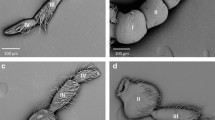Summary
There is a considerable sexual dimorphism as regards the development of the antenna inNeodiprion sertifer. In the male this is manifested in a larger antennal surface area and the possession of a great number of long single-walled sensilla (SW 1), which are located on the antennal branches. In the female the antennal branches are vestigial, and the single-walled sensilla, of a second type (SW 2), are shorter and present in lower numbers. Both sexes have in addition four types of sensilla in common:viz. a third type of single-walled sensilla (SW 3), terminal pore sensilla, double-walled sensilla, and poreless sensilla. These four sensillar types are characterized not only by their external appearance but also by their internal morphology. Especially the cells enveloping the sensory cells vary in number and appearance.
Similar content being viewed by others
References
Ahlgren, G.,Bergström, G.,Löfqvist, J.,Jansson, A.,Norin, T., 1979: Trans-perillenal, a furanoid monoterpene from pine saw-fly,Neodiprion sertifer (Hymenoptera: Diprionidae). J. chem. Ecol. (in press).
Altner, H., 1977 a: Insect sensillum specificity and structure: an approach to a new typology. In: Olfaction and taste VI (Le Magnen, J., MacLeod, P., eds.), pp. 295–308. London: Information Retrieval limited.
—, 1977 b: Insektensensillen: Bau- und Funktionsprinzipien. Verh. dtsch. Zool. Ges.70, 139–153.
—,Sass, H., Altner, I., 1977: Relationship between structure and function of antennal chemo-, hygro-, and thermoreceptive sensilla inPeriplaneta americana. Cell Tiss. Res.176, 389–405.
Berland, L., 1947: Hyménoptères tenthredoides. Faune de France, Vol. 47. Paris: Paul Lechevalier.
Birch, M. C. (ed.) 1974: Pheromones. Amsterdam-London: North Holland Publishing Company.
Ernst, K.-D., 1969: Die Feinstruktur von Reichsensillen auf der Antenne des AaskÄfersNecrophorus (Coleoptera). Z. Zellforsch.94, 72–102.
—, 1972: Die Ontogenie der basiconischen Reichsensillen auf der Antenne vonNecrophorus (Coleoptera). Z. Zellforsch.129, 217–236.
Felt, B. T., Vande Berg, J. S., 1976: Ultrastructure of the blowfly chemoreceptor sensillum (Phormia regina). J. Morph.150, 763–784.
Gaffal, K. P., 1976: Die Feinstruktur der Sinnes- und Hüllzellen in den antennalen Schmecksensillen vonDysdercus intermedius Dist. (Phyrrhocoridae, Heteroptera). Protoplasma88, 101–115.
Gnatzy, W., Weber, K. M., 1978: Tormogen cell and receptor-lymph space in insect olfactory sensilla. Cell Tiss. Res.189, 549–554.
Hawke, S. D., Farley, R. D., 1971: Antennal chemoreceptors of the desert burrowing cockroach,Arenivaga sp. Tissue & Cell3, 649–664.
Jewett, D. M., Matsumura, F., Goppel, H. C., 1976: Sex pheromone specificity in the pine sawflies: interchange of acid moieties in an ester. Science192, 51–53.
Kaissling, K. E., Kasang, G., Bestmann, H. J., Stransky, W., Vostrowsky, O., 1978: A new pheromone of the silkworm mothBombyx mori. Naturwissenschaften65, 382–384.
McIver, S., 1975: Structure of cuticular mechanoreceptors of arthropods. Ann. Rev. Entomol.20, 381–397.
Phillips, C. E., Vande Berg, J., 1976: Mechanism for sensillum fluid flow in trichogen and tormogen cells ofPhormia regina (Meigen) (Diptera: Calliphoridae). Int. J. Insect Morphol. & Embryol.5, 423–431.
Schmidt, K., 1973: Vergleichende morphologische Untersuchungen an Mechanorezeptoren der Insekten. Verh. dtsch. Zool. Ges.66, 15–25.
Seabrook, W. D., 1978: Neurobiological contributions to understanding insect pheromone systems. Ann. Rev. Entomol.23, 471–485.
Slifer, E. H., 1970: The structure of arthropod chemoreceptors, Annu. Rev. Entomol.15, 121–142.
Steinbrecht, R. A., 1973: Der Feinbau olfaktorischer Sensillen des Seidenspinners (Insecta, Lepidoptera). Z. Zellforsch.139, 533–565.
—, 1974: Morphology of insect chemoreceptors. In: Transduction mechanisms in chemoreception (Poynder, T. M., ed.), pp. 15–24. London: Information Retrieval Limited.
—,Müller, B., 1971: On the stimulus conducting structures in insect olfactory receptors. Z. Zellforsch.117, 570–575.
Thurm, U., 1970: Untersuchungen zur funktioneilen Organisation sensorischer ZellverbÄnde. Verh. dtsch. Zool. Ges.64, 79–88.
Toh, Y., 1977: Fine structure of antennal sense organs of the male cockroach,Periplaneta americana. J. Ultrastruct. Res.60, 373–394.
Whitehead, A. T., Larsen, J. R., 1976: Ultrastructure of the contact chemoreceptors ofApis mellifera L. (Hymenoptera: Apidae). Int. J. Insect Morphol. & Embryol.5, 301–315.
Author information
Authors and Affiliations
Additional information
Supported by joint grants from the Swedish Council for Planning and Coordination of Research, the Swedish Natural Science Research Council, and the Swedish Council for Forestry and Agricultural Research.
Rights and permissions
About this article
Cite this article
Hallberg, E. The fine structure of the antennal sensilla of the pine saw flyNeodiprion sertifer (Insecta: Hymenoptera) . Protoplasma 101, 111–126 (1979). https://doi.org/10.1007/BF01293440
Received:
Accepted:
Issue Date:
DOI: https://doi.org/10.1007/BF01293440




